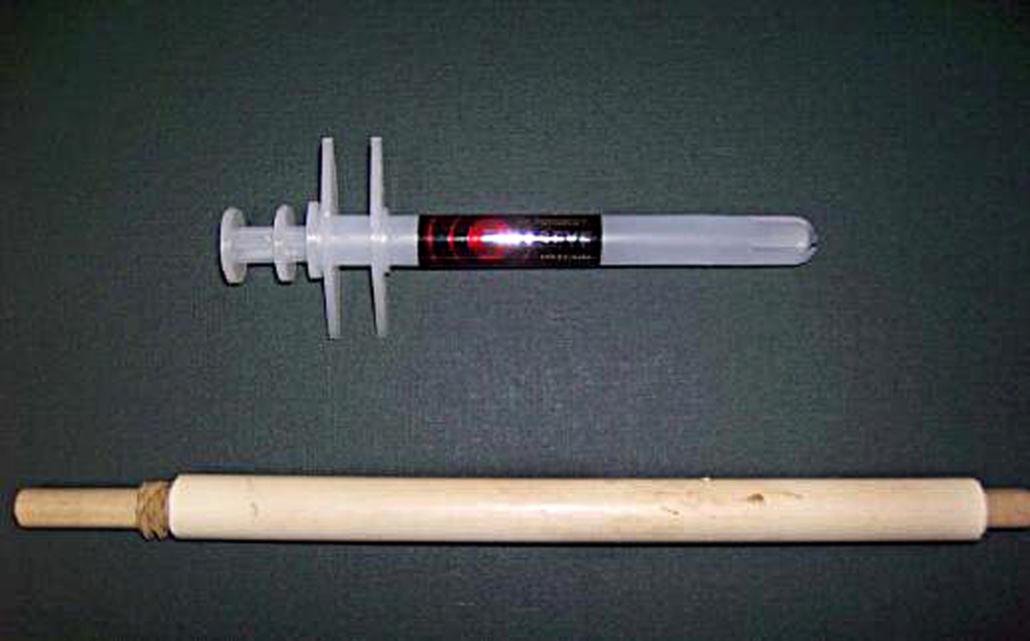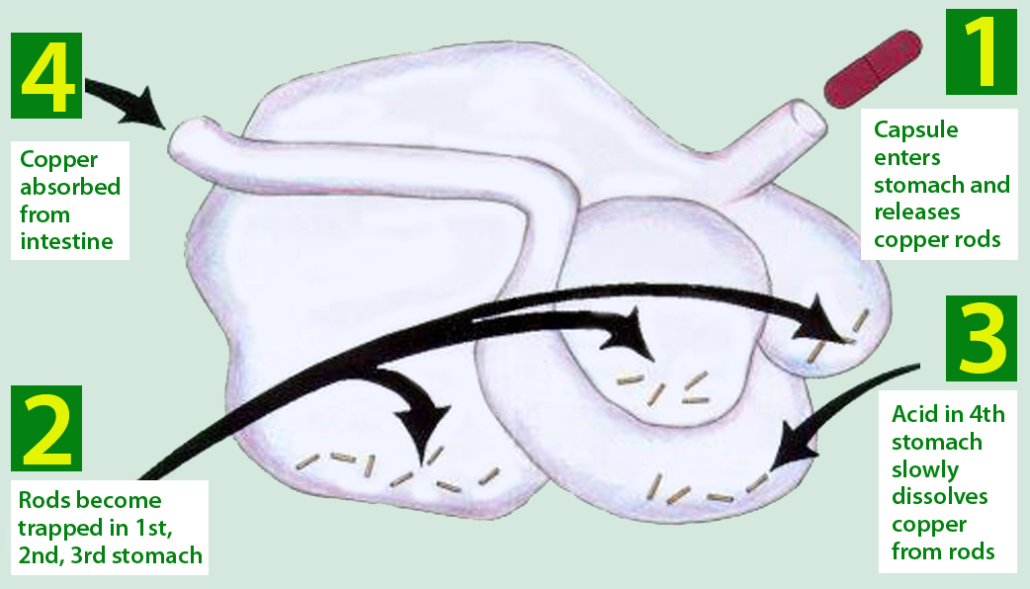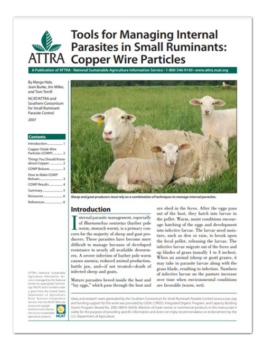Tools for Managing Internal Parasites in Small Ruminants: Copper Wire Particles

By Margo Hale, NCAT Agriculture Specialist
Joan Burke, Jim Miller, and Tom Terrill, Southern Consortium for Small Ruminant Parasite Control
Abstract
This publication produced by NCAT/ATTRA and the Southern Consortium for Small Ruminant Parasite Control describes how copper oxide wire particles can be used to treat internal parasites in sheep and goats. The publication contains information on how to make boluses of copper wire oxide particles, and reports results of studies on the effectiveness of this treatment.
Contents
Introduction
Copper Oxide Wire Particles
COWP Boluses
COWP Results
Summary
References
Introduction
Internal parasite management, especially of Haemonchus contortus (barber pole worm, stomach worm), is a primary concern for the majority of sheep and goat producers. These parasites have become more difficult to manage because of developed resistance to nearly all available dewormers. A severe infection of barber pole worm causes anemia, reduced animal production, bottle jaw, and—if not treated—death of infected sheep and goats.
Mature parasites breed inside the host and “lay eggs,” which pass through the host and are shed in the feces. After the eggs pass out of the host, they hatch into larvae in the pellet. Warm, moist conditions encourage hatching of the eggs and development into infective larvae. The larvae need moisture, such as dew or rain, to break open the fecal pellet, releasing the larvae. The infective larvae migrate out of the feces and up blades of grass (usually 1 to 3 inches). When an animal (sheep or goat) grazes, it may take in parasite larvae along with the grass blade, resulting in infection. Numbers of infective larvae on the pasture increase over time when environmental conditions are favorable (warm, wet).
Parasites are now developing resistance to all commercially available anthelmintics (dewormers). Drug resistance is the ability of worms in a population to survive drug treatment of the animal at the standard prescribed dosage. Over-use of dewormers (frequent deworming and treating all animals regardless of need) has led to dewormer resistance, and as a consequence most available dewormers are now ineffective. Producers cannot rely on anthelmintics alone to control internal parasites. Therefore, it is important to use several tools to manage internal parasites. The following are tools that can be used to manage internal parasites. For more information see ATTRA’s Managing Internal Parasites in Sheep and Goats.
Pasture Management
- Maintain forage height greater than 2 inches
- Provide areas of browse (brush, shrubs, small trees, etc.)
- Maintain low stocking rate
- Graze sheep and goats with cattle, or in a rotation with cattle or horses
- Provide tannin-rich forages, such as sericea lespedeza
- Harvest hay off pastures
- Avoid wet patches in a pasture, such as from a leaky water trough
- Fence-off naturally wet areas
Selective Deworming or FAMACHA©
- A system for classifying animals based on levels of anemia (according to eye mucous membrane color)
- Treat only animals with symptoms of the barber pole worm (anemia)
- Reduces the use of dewormers and slows development of resistance
- Is only effective for the treatment of H. contortus (barber pole worm)
Selecting Resistant Animals
- Several breeds show resistance to internal parasites
- Individual animals can demonstrate resistance to parasites
- Resistant animals have a lower host parasite burden and are not negatively affected by the parasites (don’t show signs of parasitism, remain productive)
- FAMACHA scores can be helpful for selection
Copper Oxide Wire Particles
Copper oxide wire particles (COWP) have also been found to reduce parasite loads in sheep and goats. COWP were developed for copper deficiency in cattle and sheep. Sheep are very susceptible to copper toxicity, which can result in death. The form of copper used in COWP is poorly absorbed, reducing the risk of copper toxicity.
The exact mechanism of how copper wire particles control internal parasites is not yet fully understood. Researchers believe copper has a direct effect on internal parasites. It may also help to boost the immune system. Both effects help to manage internal parasites.
Things you should know about copper…
- Copper is important for immune function in livestock.
- Sheep are very sensitive to copper accumulation in the liver, which causes toxicity.
- The amount of copper required by sheep is not greatly different from the toxic level, making copper level an important consideration when mixing sheep rations or feeding mineral.
- The margin of safety between the required amount of copper (10 ppm) and toxic level (25 ppm) is very narrow in sheep.
- Some sheep breeds are more susceptible to copper toxicity than others (Texel and dairy breeds).
- Copper sulfate is more readily absorbed than copper oxide, creating a greater risk for copper toxicity.
- Recommending COWP use for controlling worms does not endorse the use of high copper sulfate mineral mixes to control parasites.
- There are complex mineral interactions that affect copper absorption; deficiencies in other minerals can increase the risk for copper toxicity.
- Low levels of molybdenum can increase risk of copper toxicity.
- Pastures fertilized with poultry waste may have high copper levels.
- Sheep should not be fed poultry wastes, due to the high copper levels.
- Goats are less susceptible to copper toxicity, tolerating up to 80 ppm.
- While not common, copper toxicity in goats can occur (13).
Copper Oxide Wire Particle Boluses
COWP boluses can be made and administered on farm. Copper boluses (Copasure©) are available for use for copper deficiency in cattle. These boluses can be repackaged into doses suitable for growing sheep and goats. The minimum dose that has demonstrated control in some studies is 0.5 g, but as much as 2-4 g may be necessary.
Animals can be treated again after four to six weeks, if necessary. Animals should receive no more than four (if 0.5 or 1 g is used) or two (if 2 or 4 g is used) COWP boluses in a worm season. It should be noted that COWP has been found to be effective on reducing abomasal (H. contortus) only and not intestinal worms. COWP has been found to be effective against H. contortus in mature goats most of the time, though sometimes marginally effective. Other control strategies may be more effective in mature animals. As with all anthelmintic treatments, it is important to work with your veterinarian.
COWP should not be the only method used for controlling internal parasites. COWP boluses should be thought of as one component of a complete parasite management strategy. COWP boluses should be used selectively, treating only the animals that need it. Using the FAMACHA© system is one way to determine animals that should receive a COWP bolus. Selective treatment is advised to reduce the risk of worms developing resistance to COWP. Other parasite management techniques are mentioned earlier in this publication. The use of COWP can also help slow the development of anthelmintic drug resistance, as fewer anthelmintics are used.
How to make COWP boluses for parasite control in sheep and goats
- Purchase copper boluses (Copasure©, available in 12.5 g and 25 g boluses)
- Obtain smaller gel capsules
- Available at your local pharmacy or health food store, also available from veterinary supply at times
- Repackage cattle bolus into smaller gel capsule to make 0.5g dose
- Size 1 gelatin capsules filled1/3 full
- Size 3 capsules filled 3/4 full
- Administer bolus with a pill gun designed for pets or wooden dowel with PVC pipe

Suggested pill guns to administer COWP to sheep and goats. Top pill gun is marketed for dogs and cats (Dr. Hanson’s® Bullseye pill gun) and bottom is wooden dowel inserted into a ½ inch PVC pipe with a rubber band wrapped around the dowel to serve as a stop. Photo: Dr. Joan Burke

Gelatin capsules, Size 3 and Size 1, filled with 0.5 g or 500 mg of COWP. Photo: Dr. Joan Burke

Illustrates the fate of COWP boluses in the animal. (Adapted from www.animax-vet.com)
COWP Results
There have been several research trials studying the effects of COWP on internal parasites in sheep and goats. The following table summarizes the results.
| Animals Used | Treatment | Results | Notes |
|---|---|---|---|
| Crossbred (Katahdin, Dorper, St. Croix cross) ram lambs | 0.5 g or 1 g COWP every 6 weeks (May-October) | Fecal egg counts (FEC) reduced, fewer H. contortus found in fecals of lambs treated with COWP | Lower COWP doses just as effective at reducing internal parasites as higher doses in other studies. COWP was highly effective in reducing nematode infection for 4-6 weeks (3) |
| 5-6 month old hair breed lambs | 0, 2, 4, or 6 g COWP | FEC reduced in lambs receiving 2, 4, or 6 g COWP; H. contortus numbers in the abomasums were reduced (5) | |
| Mature Katahdin ewes, prior to lambing | 0, 2, or 4 g COWP | FEC reduced for those receiving COWP (2 g-66%; 4 g- 55%), FEC increased in untreated animals | Evidence that lambs received copper from treated ewes (in utero and through milKB] (4) |
| Lactating Polypay ewes and their offspring | Mature ewes—0, 0.5, 1, or 2 g COWP 60 days after lambing
Offspring—0, 0.5, 0.75, 1 or 2 g COWP at 2 months of age |
Ewes—FEC were lower for those treated with 1 or 2 g COWP
Offspring—All doses of COWP lowered FEC |
In this study, a beneficial effect for ewes was seen with 2 g COWP.
COWP appear to be less effective in mature ewes compared with lambs. (7) |
| Boer-cross yearling goats | 0, 5, or 10 g COWP bolus | FEC were lower for animals treated with COWP | While FEC were lower for animals treated with COWP, they still were over 2000 eggs/g. (9) |
| Boer-cross weanling goats | 0 or 2.5 g COWP | FEC initially decreased by ~50% (from 2930 eggs/g to 1525 eggs/g) for those treated with COWP, but then rose to over 3000 eggs/g | FEC started to rise 3 weeks after COWP treatment. (10) |
| Mature Spanish does grazing winter pasture | 0 or 4 g COWP | Overall FEC were similar between 0 and 4 g COWP. | On days 0, 7, and 14 FEC of untreated goats increased while FEC of COWP treated goats remained low. (8) |
| Yearling Spanish x boer cross bucks | 0, 5, or 10 g COWP | FEC were similar in 0, 5, or 10 g COWP treated goats and decreased between day 0 and 35. | Concentrations of copper in the liver were greater in COWP-treated goats than untreated goats. (8) |
| Boer x Spanish doe and wether kids | 0, 0.5, 1, 2, or 4 g COWP | FEC were lower on days 7, 14, and 21 compared with untreated kids, but were similar by day 28. | Average daily gain tended to increase with dose of COWP up to 2 g then decreased at 4 g. (8) |
| Boer x Spanish wether kids | 0 g COWP, 5 g COWP, apple cider vinegar drench, or vinegar drench and 5 g COWP | There was no effect of vinegar drenching on FEC in 0 or 5 g COWP treated kids. FEC were reduced in COWP treated kids. (8) | |
| Boer and Spanish x Boer does | 0 or 2 g COWP while supplemented with 220 g of corn and soybean meal or 220 g of cottonseed meal | FEC were reduced in COWP treated goats and remained lower than untreated does until day 21 for corn soybean meal-supplemented does and day 28 in cottonseed meal-supplemented does. FEC were lower in CSM than corn soybean meal-supplemented does that received COWP. | At the end of this study, 2 g COWP was administered to all goats and resulted in a 79% reduction in FEC 7 days later. (8) |
| Boer yearling does | 0 or 5 g COWP grazing either tall fescue or sericea lespedeza | Doses of 5 g COWP decreased FEC and sericea lespedeza grazing tended to decrease FEC. | By day 28 approx. 50% of untreated does required deworming, but no COWP-treated does required deworming. (8) |
| Yearling Spanish does, prior to breeding | Multi-trace element/vitamin ruminal bolus containing copper oxide | Fecal egg counts were reduced (by 80%) and remained low, while untreated animals’ FEC increased (6) | |
| Spanish and Boer does, 6 weeks before kidding | Multi-trace element/ vitamin ruminal bolus containing copper oxide | H. contortus decreased; FEC were reduced (by 60%) | Reduction in FEC lasted 3-4 weeks, similar to anthelmintic treatments (6) |
Summary
Copper oxide wire particles (COWP) have been proven to be an effective method of controlling H. contortus (barber pole worm) in sheep and goats. While COWP have shown positive results in reducing parasite loads, they should not be the only method of parasite control used. Research continues on the use of COWP to determine the most effective treatments for sheep and goats. COWP can be an effective component of a holistic parasite management strategy.
References
1) Hale, M. 2006. Managing Internal Parasites in Sheep and Goats. ATTRA publication.
2) Burke, J.M., Miller, J.E., & Terrill, T.H. 2007. Use of Copper Oxide Wire Particles (COWP) to Control Barber Pole Worm in Lambs and Kids.
3) Burke, J.M. & J.E. Miller. 2006. Evaluation of multiple low doses of copper oxide wire particles compared with levamisole for control of Haemonchus contortus in lambs. Veterinary Parasitology (139). p. 145-149.
4) Burke, J.M., Miller, J.E., & D.K. Brauer. 2005. The effectiveness of copper oxide wire particles as an anthelmintic in pregnant ewes and safety to offspring. Veterinary Parasitology (131). p. 291-297.
5) Burke, J.M., Miller, J.E., Olcott, D.D., Olcott, B.M., & T.H. Terrill. 2004. Effect of copper oxide wire particles dosage and feed supplement level on Haemonchus contortus infection in lambs. Veterinary Parasitology (123). p. 235-243.
6) Burke, J.M. & J.E. Miller. 2006. Control of Haemonchus contortus in goats with a sustained-release multi-trace element/vitamin ruminal bolus containing copper. Veterinary Parasitology (141). p. 132-137.
7) Burke, J.M., Morrical, D., & Miller, J.E. 2007. Control of gastrointestinal nematodes with copper oxide wire particles in a flock of lactating Polypay ewes and offspring in Iowa, USA. Veterinary Parasitology (146). p. 372-375.
8) Burke, J.M., Terrill, T.H., Kallu, R.R., Miller, J.E., J. Mosjidis. 2007. Use of copper oxide wire particles to control gastrointestinal nematodes in goats. Journal of Animal Science (85). p. 2753-2761.
9) Glennon, H.M., Luginbuhl, J-M., Mueller, J.P., Zajac, A.M., Anderson, K.L., Spearks, J.W., Brown, T.T., & C. Brownie. 2004. Effect of copper oxide needles on gastrointestinal parasites in grazing meat goats. Journal of Animal Science 80 (Suppl. 2): 29.
10) Luginbuhl, J-M., Glennon, H.M., & J.P. Mueller. 2006. Effect of copper-oxide needles on gastrointestinal parasites in weanling meat goats control-grazed on bermudagrass pastures. Journal of Animal Science 84 (Suppl. 2): 21.
11) Copasure© information.
12) Schoenian, S. 2000. Copper Toxicity in Sheep.
13) Cornish, J., Angelos, J., Puschner, B., Miller, G., & L. George. 2007. Copper toxicosis in a dairy goat herd. Journal of American Veterinary Medicine Association (231). p. 586-589.
Tools for Managing Internal Parasites in Small Ruminants: Copper Wire Particles
By Margo Hale, NCAT Agriculture Specialist; Joan Burke, Jim Miller, and Tom Terrill, Southern Consortium for Small Ruminant Parasite Control
Published November 2007
© NCAT
IP317
Slot 316
This publication is produced by the National Center for Appropriate Technology through the ATTRA Sustainable Agriculture program, under a cooperative agreement with USDA Rural Development. This publication was also made possible in part by funding from USDA, CSREES, Integrated Organic Program, and Capacity Building Grants Program, Award No. 2005-38814-16429. ATTRA.NCAT.ORG.
Mention of trade names or commercial products in this manuscript is solely for the purpose of providing specific information and does not imply recommendation or endorsement by NCAT, ATTRA, or the U.S. Department of Agriculture.

